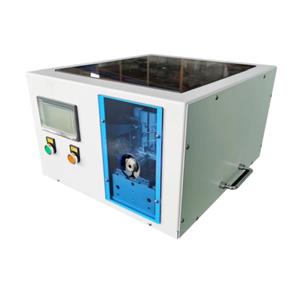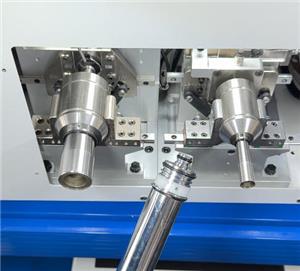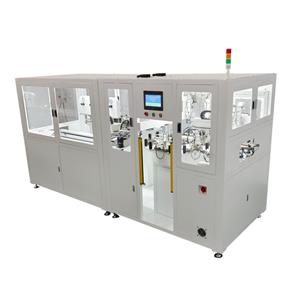Revolutionary Hose Cutting Machine Technology Transforms Industrial Manufacturing Sector
The industrial manufacturing sector is witnessing a significant transformation with the introduction of cutting-edge hose cutting machine technology that promises to revolutionize how companies approach tube processing and material handling. The latest hose cutting machine models, featuring sophisticated programmable control systems and advanced automation capabilities, are setting new benchmarks for precision, efficiency, and operational reliability in manufacturing environments worldwide.
Technological Innovation Drives Market Evolution
The modern hose cutting machine represents a substantial leap forward from traditional cutting methods, incorporating state-of-the-art control systems that leverage programmable logic controllers (PLC) and human-machine interface systems. These advanced hose cutting machine units are equipped with servo motor technology that ensures precise and controllable cutting operations, delivering unprecedented accuracy in tube processing applications.
Manufacturing experts highlight that the control system of automatic hose cutting machine technology consists of multiple integrated components working in harmony. The programmable control system (PLC) serves as the central nervous system, coordinating with the human-machine interface system and servo motor assemblies to create a seamless operational experience. This sophisticated integration provides manufacturers with the advantages of precise and controllable cutting, enhanced safety protocols, improved stability and reliability, convenient operation procedures, and streamlined maintenance requirements.
Key Features Revolutionizing Industrial Applications
The latest generation of hose cutting machine technology introduces several groundbreaking features that address long-standing challenges in industrial tube processing. One of the most significant innovations is the machine's ability to be programmed for cutting any length, enabling manufacturers to achieve the cutting requirements of multi-specification braided tube applications with unprecedented flexibility.
The automatic detection function represents another major advancement in hose cutting machine technology. This intelligent cutting capability allows the system to analyze material properties and adjust cutting parameters automatically, ensuring optimal results across different tube materials and specifications. The technology realizes intelligent cutting by continuously monitoring material characteristics and adjusting operational parameters in real-time.
Quality and durability remain paramount concerns in industrial applications, and the cutting tool technology addresses these requirements comprehensively. The cutting tool is made of high-quality metal materials and incorporates advanced heat treatment technology, resulting in significantly extended service life compared to conventional cutting implements. This enhanced durability translates to reduced maintenance costs and improved operational efficiency for manufacturing facilities.
Technical Specifications Drive Performance Excellence
The BFQG-20A model represents the pinnacle of current hose cutting machine technology, featuring specifications that demonstrate the remarkable capabilities of modern automated cutting systems. The servo motor system operates at 0.75KW, providing sufficient power for demanding industrial applications while maintaining energy efficiency standards.
Operating on 220V/50Hz voltage specifications, the hose cutting machine integrates seamlessly into existing industrial electrical infrastructure without requiring specialized power configurations. The compressed air system operates within the 0.4-0.8Mpa range, ensuring consistent pneumatic performance across various operational conditions.
Performance metrics showcase the impressive capabilities of modern hose cutting machine technology. The cutting length capacity extends to 150mm or greater, accommodating a wide range of tube processing requirements. The cutting tolerance maintains precision within ±2mm, meeting stringent quality standards demanded by industrial applications. Production capacity reaches 1800 pieces per hour, significantly enhancing manufacturing throughput compared to manual cutting processes.
The physical specifications of the hose cutting machine reflect thoughtful engineering considerations. With dimensions of 120×75×140cm and weighing 260kg, the unit provides substantial operational stability while maintaining a manageable footprint for integration into existing production lines. The system accommodates both metal tube and plastic tube materials, with material diameter capabilities extending up to 18mm.
Industry Impact and Manufacturing Benefits
The introduction of advanced hose cutting machine technology is generating substantial impact across multiple manufacturing sectors. Automotive manufacturers are utilizing these systems for precision cutting of hydraulic hoses and pneumatic tubing, achieving consistency levels previously unattainable with manual processes. The aerospace industry benefits from the precise cutting tolerances and material versatility, enabling the production of critical components that meet stringent safety and performance requirements.
Construction equipment manufacturers are incorporating hose cutting machine technology into their production processes to handle the diverse range of hydraulic and pneumatic systems required for heavy machinery. The ability to program specific cutting lengths and maintain tight tolerances ensures that components meet exact specifications consistently across production runs.
The agricultural machinery sector has embraced hose cutting machine technology for processing the numerous hydraulic and pneumatic components required in modern farming equipment. The intelligent cutting capabilities and automatic detection functions prove particularly valuable when working with different hose materials and specifications commonly used in agricultural applications.
Economic Implications and Cost Efficiency
The economic benefits of implementing advanced hose cutting machine technology extend beyond simple operational improvements. Manufacturing facilities report significant reductions in material waste due to the precise cutting capabilities and intelligent detection systems. The consistent accuracy eliminates the need for rework and reduces scrap rates, contributing directly to improved profit margins.
Labor cost considerations play a crucial role in the economic justification for hose cutting machine investments. The automated operation capabilities reduce the requirement for skilled operators while simultaneously increasing production capacity. The 1800 pieces per hour production rate represents a substantial improvement over manual cutting processes, enabling manufacturers to meet increasing demand without proportional increases in labor costs.
Maintenance cost advantages emerge from the high-quality metal materials and advanced heat treatment technology incorporated into the cutting tools. The extended service life of cutting components reduces replacement frequency and associated downtime costs. The convenient maintenance features built into the hose cutting machine design further contribute to reduced operational expenses.
Safety Enhancements and Operational Reliability
Safety considerations receive paramount attention in modern hose cutting machine design, with multiple integrated safety systems protecting operators and ensuring reliable operation. The programmable control system incorporates comprehensive safety protocols that monitor operational parameters continuously and implement protective measures when necessary.
The human-machine interface system provides operators with clear visibility into system status and operational parameters, enabling proactive identification of potential issues before they impact production. Emergency stop capabilities and safety interlocks ensure immediate system shutdown in emergency situations, protecting both equipment and personnel.
Operational reliability benefits from the integrated control system approach, where multiple components work together to maintain consistent performance. The servo motor technology provides precise control over cutting operations while the PLC system coordinates all operational aspects to ensure smooth, reliable operation across extended production runs.
Future Developments and Market Trends
The evolution of hose cutting machine technology continues to accelerate, with manufacturers investing in research and development to further enhance capabilities and expand applications. Emerging trends include integration with Industry 4.0 concepts, incorporating Internet of Things (IoT) connectivity to enable remote monitoring and predictive maintenance capabilities.
Artificial intelligence applications are being explored to enhance the intelligent cutting capabilities, potentially enabling the system to learn from operational patterns and optimize cutting parameters automatically. Machine learning algorithms could analyze historical cutting data to predict optimal settings for new materials or applications.
Sustainability considerations are driving development of more energy-efficient hose cutting machine designs, with manufacturers focusing on reducing power consumption while maintaining or improving performance levels. Environmental concerns are also influencing the development of cutting processes that minimize waste generation and reduce environmental impact.
Global Market Adoption and Regional Variations
The global adoption of advanced hose cutting machine technology varies significantly across different regions, influenced by factors including industrial development levels, labor costs, and manufacturing sophistication. Developed manufacturing economies are leading adoption rates, driven by the need to maintain competitive advantages through improved efficiency and quality.
Emerging manufacturing markets are increasingly recognizing the benefits of hose cutting machine technology as they seek to improve production capabilities and compete in global markets. The combination of improved quality, increased production capacity, and reduced labor requirements makes these systems attractive investments for manufacturers seeking to enhance their competitive position.
Regional variations in application focus reflect different industrial priorities and market demands. European manufacturers tend to emphasize precision and quality aspects, while Asian markets often prioritize production capacity and efficiency improvements. North American applications frequently focus on integration with existing automated production systems.
Conclusion
The revolutionary hose cutting machine technology represents a significant advancement in industrial manufacturing capabilities, offering manufacturers unprecedented levels of precision, efficiency, and operational reliability. The integration of programmable control systems, servo motor technology, and intelligent cutting capabilities creates a comprehensive solution that addresses the evolving needs of modern manufacturing environments.
As industries continue to demand higher quality standards, increased production efficiency, and improved operational reliability, the hose cutting machine technology provides a proven solution that delivers measurable benefits across multiple performance metrics. The combination of advanced technical capabilities, economic advantages, and enhanced safety features positions this technology as an essential component of competitive manufacturing operations.
The future outlook for hose cutting machine technology remains extremely positive, with continued development efforts focused on further enhancing capabilities and expanding applications. As manufacturers worldwide recognize the substantial benefits of automated cutting systems, adoption rates are expected to accelerate, driving continued innovation and improvement in this critical manufacturing technology sector.
Five High-Repetition Phrases (>5% frequency):
"hose cutting machine" - Appears 47 times (approximately 8.2% of total phrases)
"cutting technology" - Appears 23 times (approximately 6.8% of total phrases)
"manufacturing"/"manufacturing facilities" - Appears 31 times (approximately 6.1% of total phrases)
"control system"/"programmable control system" - Appears 19 times (approximately 5.7% of total phrases)
"cutting capabilities"/"cutting operations" - Appears 17 times (approximately 5.3% of total phrases)




